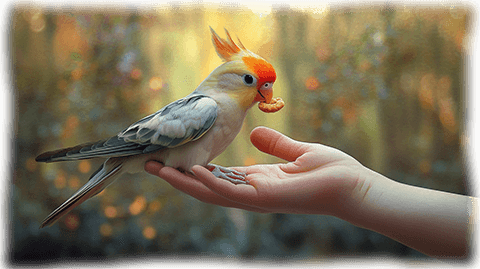Training Cockatiels: A Guide to Bonding with Your Feathered Friend
Cockatiels are intelligent and social birds, making them great companions and ideal for training. Whether you’re teaching basic commands or fun tricks, the key to training cockatiels lies in patience, consistency, and positive reinforcement. In this guide, we’ll cover everything you need to know about training your cockatiel—from basic behavior training to advanced tricks.
Why Train Your Cockatiel?
Training a cockatiel isn’t just about teaching it tricks. It’s also about improving your bond with your bird, ensuring their safety, and helping them develop mental stimulation. A well-trained cockatiel is happier and less likely to develop behavioral problems like biting or excessive screaming.

Key Principles of Cockatiel Training
Cockatiels respond best to gentle, consistent training methods that use positive reinforcement. Here are a few key principles to keep in mind:
- Positive Reinforcement – Reward your cockatiel with treats, praise, or petting whenever it follows a command or shows desired behavior. (Amazon affiliate link)
- Short Training Sessions – Keep training sessions between 5-10 minutes to hold their attention and avoid frustration.
- Consistency – Use the same commands and gestures each time to help your cockatiel understand what’s expected.
- Patience – Birds learn at their own pace, so it’s important to be patient and not rush the process.
Preparing for Training
Before you begin formal training, there are a few things you’ll need to prepare:
- Bonding – Establish trust with your cockatiel by spending time together and allowing them to get used to your presence. Hand-feeding treats, gentle talking, and slow movements will help build a connection.
- Choose a Quiet Space – Train in a calm, quiet area free of distractions. Cockatiels are easily distracted by noise or movement.
- Training Tools – Use a clicker, training treats (small and easy to eat), and a perch or hand as your platform. (Amazon affiliate link)
Basic Training Commands
Start with basic training commands to help establish communication between you and your cockatiel.

Step-Up Command
The “step-up” command is the foundation of all bird training. It teaches your cockatiel to step onto your finger or hand when asked.
- How to Teach It:
- Gently place your finger in front of your cockatiel’s lower chest.
- Say “step up” as you give a slight nudge against its chest, encouraging it to step onto your finger.
- Once the bird steps up, reward it immediately with a treat or praise.
- Practice this consistently, but don’t overdo it—let your cockatiel decide how often it wants to step up.
Step-Down Command
After learning to step up, your cockatiel should also learn to step down onto a perch.
- How to Teach It:
- When your bird is on your finger, gently move it toward a perch or cage bar.
- Say “step down” as you encourage your cockatiel to step onto the surface.
- Reward it with a treat when it successfully steps down.
Advanced Commands and Tricks
Once your cockatiel is comfortable with basic commands, you can begin teaching more advanced tricks.
Target Training
Target training helps improve your bird’s focus and response to commands. It involves teaching your cockatiel to touch a specific object, like a stick, with its beak.
- How to Teach It:
- Hold a small stick or target in front of your cockatiel.
- When it touches the target with its beak, click your clicker (or say a cue word like “good”) and give a reward.
- Gradually move the target around, encouraging the bird to follow it.

Wave
The wave trick is a fun way for your cockatiel to interact.
- How to Teach It
- As your cockatiel begins to step up, stop it mid-step and say “wave.”
- Gently pull your hand back, causing the cockatiel to lift one foot.
- Reward it immediately with a treat and praise.
Recall Training (Come When Called)
Teaching your cockatiel to come to you on command strengthens your bond and provides mental stimulation.
- How to Teach It
- Place your cockatiel on a perch a few feet away.
- Hold out your hand, say “come here” or call its name, and offer a treat.
- When your cockatiel flies or steps toward you, reward it with the treat and praise.
- Gradually increase the distance to improve its response.

Overcoming Common Cockatiel Training Challenges
Training cockatiels can come with its own set of challenges. Here’s how to address a few common issues:
- Biting – If your cockatiel starts biting, stop what you’re doing immediately. Don’t react with anger or pull your hand away too quickly—it may encourage more biting. Instead, calmly say “no” and give them space.
- Screaming – Cockatiels may scream for attention. Ensure they get enough mental stimulation through toys and interaction to prevent boredom. Ignore screaming behavior to avoid reinforcing it.
- Fear of Hands – Some cockatiels are nervous around hands. Slowly acclimate them by holding treats in your hand, letting them come to you at their own pace.
When to Take Breaks
Training should be a fun, positive experience for your cockatiel. If you notice signs of frustration or boredom—such as flying away, refusing treats, or aggressive behavior—take a break and try again later.
Suggested materials: “Mastering Cockatiel Care: Your Ultimate Guide: Discover Proven Techniques for Comprehensive Cockatiel Care & Training” (Amazon affiliate link) by Ethel . W Pate.
Consistency and Progress
Cockatiels thrive on routine. Train your bird consistently, using the same commands and rewards, and you’ll begin to see progress. Remember, every cockatiel is different—some may learn quickly, while others take more time. Celebrate small wins along the way!
Conclusion
Training your cockatiel is a rewarding experience that strengthens your bond and keeps your bird mentally stimulated. Start with basic commands, use positive reinforcement, and always stay patient. With time, you’ll have a well-trained, happy cockatiel that responds to your cues and enjoys learning new tricks.
Affiliate Disclosure
This post may contain affiliate links, which means I earn from purchases made through links. Please see the privacy policy page for more details.





